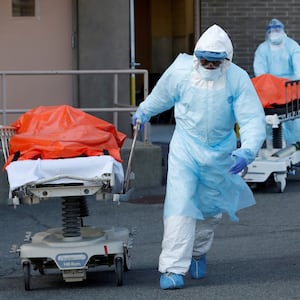When Donald Trump suggested people besides himself wear cloth masks in public last week, it reignited a festering debate about whether the 2019 novel coronavirus is airborne.
For months, the Centers for Disease Control and Prevention (CDC) took the same position that the World Health Organization (WHO) currently has—that masks for healthy people aren’t necessary, as long as they practice social distancing and stay at least six feet away from each other. The agencies have maintained that the virus is transmitted by either direct contact with an infected person, fomites—an infected surface like a door handle—or from droplets that are produced when someone coughs or sneezes.
But there’s mounting evidence that transmission may occur via aerosols, or viral particles produced during exhalation by way of talking, breathing, singing, and even outdoor exercise. And, some experts and critics of the new CDC guidelines say, there’s little evidence that cloth masks offer much protection from that terrifying possibility.
Perhaps most notoriously, 45 of the 60 members of a choir group in Washington—none of whom say they shook hands or had physical contact with the other members—tested positive for the novel coronavirus. Experts hypothesized that the forceful exhalation of air from singing released enough viral particles to infect a majority of the singers. A study last month from the University of Nebraska Medical Center found that particles containing traces of the virus’ RNA were found on windowsills and ventilation grates in the rooms of patients with relatively mild symptoms—i.e. likely not consistently producing a lot of droplets through coughing, sneezing, etc.
Aerosolized particles are primarily a concern in enclosed spaces, with the most significant implications for health-care workers who perform procedures like intubation that produce “lots and lots of small particles,” according to Dr. Lisa Brosseau, an expert on respiratory protection and infectious diseases who taught at the University of Illinois. “But even just being in an enclosed space with a lot of infected patients is going to expose [a health-care worker] to a high concentration of particles,” she told The Daily Beast.
The University of Nebraska researchers who found traces of the virus around the rooms of COVID-19 patients with mild symptoms are in the final stages of a study to determine if “live” virus (virus with the ability to infect someone) can be found in the air. But given how transmissible the virus is, according to Brosseau, it seems likely. “I’m skeptical that this is all contact or droplet transmission and no inhalation of small particles unto the lower respiratory system,” she said.” It just seems unlikely that we’re getting so much transmission if that’s the only way.”
Dr. George Rutherford, an epidemiologist at the University of California-San Francisco’s School of Medicine, disagrees. “If this was aerosolized, you would have seen 1.4 billion people infected in China,” he told The Daily Beast. When University of Nebraska Medical Center’s follow-up study is published, Rutherford said, he doubts they’ll have found live virus in any of the samples. “What they found was the fingerprint of the virus, not the actual virus. It’s like if you were in a room and left a piece of your hair behind. It doesn’t mean you’re still in the room.”
What a person exhales, Rutherford argued, are droplets. They might be much smaller than the droplets produced by a sneeze, but they don’t meet the specific definition of “aerosol” as it pertains to public health. For a virus to be aerosolized by the technical definition, it has to be smaller than 5 microns in diameter and be able to travel more than two meters away from the infected patient. Which is to say that what happened with the choir in Washington, for instance, could technically be the result of droplet transmission.
The reality of how the public will interpret transmission is obviously more complicated. If you’re told you can go to choir practice as long as you practice social distancing and don’t have any physical contact with your fellow singers, becoming infected simply thanks to the exhalation of others is going to seem a lot like airborne transmission.
But “the paradigm of droplet and airborne transmission just isn’t accurate,” Brosseau argued. It gives people the impression that transmission is binary—the virus is either transmitted through droplets or through the air. Realistically, it’s more of a spectrum, where on one end you have highly contagious viruses that can survive in the air for a significant period of time, and less contagious viruses that don’t survive well in the air on the other end.
The sentiment was echoed by Dr. Joshua Santarpia, lead researcher on the University of Nebraska Medical Center study. “There are no hard lines, no magic,” he told The Daily Beast. “Five microns isn’t magic, even though that’s kind of the way it's treated.”
Instead of droplet or airborne transmission, Brosseau added, we should be thinking about the size and concentration of viral particles. When we talk, breathe, cough, or sneeze, we’re producing particles. Some of those particles may be droplets and others may be aerosolized. If you’re infected with a virus, it’s very possible virus will be inside the particles you produce—a 2018 study of students with influenza found that 39 percent of sampled fine aerosols contained infectious virus. The size and concentration of these particles will differ depending on if they were produced by a cough or an exhaled breath, but the underlying principle is the same. Large particles will fall to the floor relatively quickly; small particles will travel further. Small particles don’t necessarily have a smaller “viral load”—a term Americans have become increasingly familiar with amid the pandemic—according to Brosseau.
“A least a couple of studies of influenza and SARS have shown that smaller particles have larger amounts of viable virus,” said Brosseau. “We don’t know for sure why that is but we hypothesize that smaller particles are generated from the deeper part of your lungs, where there’s more infection.” Those smaller particles can travel farther and are more likely to slip through protective masks. A 2017 study examining the efficacy of cloth masks in filtering five different sizes of diluted diesel particles found that cloth masks were “only marginally beneficial” in filtering all but the largest of the five particle sizes. Small particles are particularly concerning with the novel coronavirus, Brosseau said, because “they’re inhalable into the deep lung, and we know pneumonia in the deep lung is where the worst damage is being done.”
So what does this mean for the use of cloth masks? “If an infected person wearing a cloth mask coughs, there’s some possibility the mask could block the lateral projection of large particles,” Brosseau said. “But it’s not going to do much of anything for those smaller particles.” For that reason, she disagrees with the CDC’s new guidance. “I don’t think it should be a blanket recommendation,” she said. “It gives people a false sense of security and encourages them to stop isolating, which is really the only thing that’s going to work.”
Rutherford agrees social distancing is essential, and that cloth masks don’t provide the same kind of barrier as someone wearing a perfectly fitting N95 mask. But, he argued, “Don’t let perfect be the enemy of the good.” A 2013 influenza study supported his conclusion, finding that cloth masks should “be used as a last resort” but are “better than no protection.”
On Wednesday, the CDC issued additional new guidelines for essential workers who have potentially been exposed to COVID-19. (The CDC defines potentially exposed as “having close contact within six feet of an individual with confirmed or suspected COVID-19.”) The guidelines state that as long as the employee is asymptomatic, practices social distancing, regularly disinfects surfaces, and wears a mask for 14 days after exposure, they can return to work. This despite preemptive, harrowing warnings from experts, and an emerging consensus that many people are asymptomatic and still able to transmit the virus.
When contacted for comment by The Daily Beast, Martha Sharan, a spokesperson for the CDC, stressed that the latest guidelines were for essential workers. She added that those employees should be “screened before entering work, monitor themselves for COVID-19 symptoms, wear a face cloth, and continue to social distance.”
Regarding the effectiveness of cloth masks, Sharan directed The Daily Beast to this study, which concludes, “a hand-fashioned mask can provide a good fit and a measurable level of protection from a challenge aerosol. Problems remain.”
And when it came to whether COVID-19 might be effectively airborne in general, Sharna wrote, “The contribution of aerosolized particles to close proximity transmission is currently uncertain. However, airborne transmission from person-to-person over long distances is unlikely."
But the risk of viral particles in the air is why one New York physician, who asked that he not be identified for fear of professional retaliation, has been begging administrators at his hospital for better protection. While N95 masks filter the majority of particles, he said, he believes it’s unlikely that even those masks can filter such high concentrations of small particles (in fact, the “95” in N95 means that when the mask is fitted properly, “the respirator blocks at least 95 percent of very small particles.”)
“I’ve been raising the alarm about this for over a month,” he said. “We need COVID patients isolated in negative pressure rooms [a room that lowers air pressure to keep air from escaping] and positive pressure hoods [typically hoods or full face masks that purified air is pumped into to protect the wearer from contaminated air].” Brosseau agrees. “The goal is to break the pathway from the infected person to the health-care worker,” she said. “People always ask me, ‘What type of respirator should I be wearing?’ My answer is always, ‘Well, have you put a good ventilation system in the room? You want to prevent the hospital worker from being stuck in contaminated air.’”
Still, with so many COVID-19 patients and so few resources, N95 masks are health-care workers’ best, most realistic bet—when they can get them. As for the general public, Brosseau said it’s fine if wearing a cloth mask makes people feel more comfortable, as long as they understand that such masks haven’t been proven to be very effective at filtering those small particles.
“It makes me cringe to think of the Surgeon General on video showing people how to make a cloth mask when [their effectiveness] is so unproven,” she said. “Social distancing, social distancing, social distancing. Right now, that’s the only way we’re going to stop the spread of this virus.”








